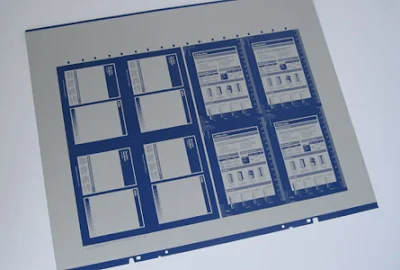 |
Offset printing plates are what transfers an image from the ink supply to the paper. They are usually made from paper, rubber, plastic or metal depending on the printing process. Printing plates have an image that is burned onto them. This image will transfer the ink to the paper.
Most offset printing plates are made from aluminum. The reason is that the metal is long-lasting and has special properties that attract water.
An aluminum printing plate can be considered an offset printing plate when it completes three steps. For a more detailed explanation as to how the actual aluminum plate is made, see this article.
 |
| Blue coating on offset printing plate. |
Step 1. A blue coating shown above is applied to the aluminum sheet about 1μm thick.
Here are some of the coatings that are applied.
- Silver Halide (printing runs 0-3000 copies). This is a photosensitive material, similar to that which used to be used in photographic film.
- Diazo (printing runs 0-250,000 copies) This is an organic compound. It provides a durable image that is the most popular today, especially for sheetfed printing presses.
- Photopolymer (0-1,000,000 copies) This coating has more durability. It can withstand more and hence will wear much slower. Longer run offset printing presses will use this for magazines and newspapers.
- Silicone. This is for what is called "waterless printing". The silicone is such that it can repel ink and allow ink to contact anywhere without the coating. Thus eliminating the need to balance ink and water in the process.
Step 2. The offset printing plate is processed by a device called an image setter.
This device burns the image onto the plate and leaves the coating on the plate where the image belongs as shown below.
The offset printing plate in the picture above shows blue areas that have been "burned" by a laser. This is the coating that has been left after the laser does it's work. These areas of the plate have special properties that attract ink. In other words, they are oleophilic.
Step 3. The plate is put on a printing press by attaching it to a round cylinder and tucking the edges into a gap.
The oleophilic areas (areas that will attract the ink) will then stick to the ink. However the areas with water will not attract the ink since the ink is oil based and so they repel one another.
Why is the term OFFSET used when referring to these printing plates?
The reason that the term "offset" is used is because the plate will run against another large cylinder and press the image onto it before it presses on to the paper. This is where the term offset comes from because the plate doesn't directly touch the paper. It offsets onto another rubber coated cylinder before touching the paper.
For a more detailed explanation of how printing plates are made, see this article. It explains the process right from the mining process to the printing press.



Comments
Post a Comment